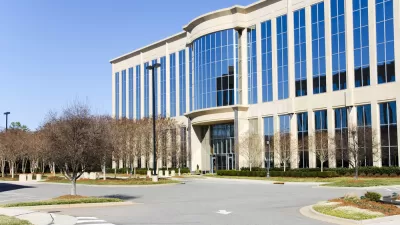Matt Bevilacqua speaks with Ellen Dunham-Jones, renowned co-author of Retrofitting Suburbia, about the key factors impacting suburban redevelopment and the recent retrofit projects across the country that have caught her eye.
The topics touched upon in their discussion, conducted in advance of the twentieth Congress for the New Urbanism being held in May, include the demographic shifts changing how Americans view their ideal neighborhood, whether the marketplace has altered its view of the traditional suburban paradigm, and recent exceptional projects.
One type of innovative retrofit that has caught Dunham-Jones' attention are re-greening projects. "It was very common, before the Clean Water Act, for commercial properties in suburbs to be built on the wetlands. We'd drain them and put in some culverts. Now that those properties are going dead, there is an opportunity to either reconstruct the wetlands or put in parks. We're finding that dead property is reducing property value around it, but if you put in a park or well-designed bioswales and other kinds of green infrastructure, you are increasing neighborhood property value."
Speaking of the overall shift towards suburban retrofitting as a growing area of practice, Dunham-Jones contends that, "The argument that June [Williamson] and I make-and I think it resonates well with students-is that we spent the past 50 years designing and developing suburbia, and yet all of the unintended consequences of that, and the continued resource depletion that we're very well aware of, means that the big design project for the next generation is going to be retrofitting suburbia."
FULL STORY: INTERVIEW: Ellen Dunham-Jones’ “Big Design Project for the Next Generation”

Trump Administration Could Effectively End Housing Voucher Program
Federal officials are eyeing major cuts to the Section 8 program that helps millions of low-income households pay rent.

Planetizen Federal Action Tracker
A weekly monitor of how Trump’s orders and actions are impacting planners and planning in America.

Ken Jennings Launches Transit Web Series
The Jeopardy champ wants you to ride public transit.

Opinion: Transit Agencies Must View Service Cuts as Last Resort
Reducing service could cripple transit systems by pushing more riders to consider car ownership, making future recovery even less certain.

‘Smart Surfaces’ Policy Guide Offers Advice for Building and Maintaining Urban Tree Canopies
Healthy, robust tree canopies can reduce the impacts of extreme heat and improve air quality.

New Jersey Lawsuit Targets Rent-Setting Algorithms
The state of New Jersey is taking legal action against landlords and companies that engage in what the state’s Attorney General alleges is illegal rent fixing.
Urban Design for Planners 1: Software Tools
This six-course series explores essential urban design concepts using open source software and equips planners with the tools they need to participate fully in the urban design process.
Planning for Universal Design
Learn the tools for implementing Universal Design in planning regulations.
Heyer Gruel & Associates PA
Ada County Highway District
Institute for Housing and Urban Development Studies (IHS)
City of Grandview
Harvard GSD Executive Education
Toledo-Lucas County Plan Commissions
Salt Lake City
NYU Wagner Graduate School of Public Service




























